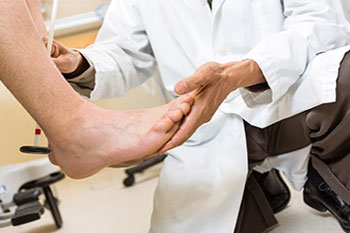 The two main muscles of the calf—the soleus and the gastrocnemius—merge above the heel and attach to the Achilles tendon. When there is tightness in the Achilles tendon or one of these calf muscles, it may lead to limited motion and flexibility of the ankle joint. Specifically, it can cause plantar pressure wounds (especially in diabetics), foot deformities, and may make it very difficult to walk and bend the foot up towards the shin of the leg. This condition is known as equinus.
The two main muscles of the calf—the soleus and the gastrocnemius—merge above the heel and attach to the Achilles tendon. When there is tightness in the Achilles tendon or one of these calf muscles, it may lead to limited motion and flexibility of the ankle joint. Specifically, it can cause plantar pressure wounds (especially in diabetics), foot deformities, and may make it very difficult to walk and bend the foot up towards the shin of the leg. This condition is known as equinus.
People with equinus often change the way they walk to compensate for their limited ankle motion and pain. They may bend unnaturally at the knee or hip, toe walk, or pick the heel up early in the gait cycle. Equinus may lead to other foot, leg or back problems such as:
- Flat feet
- Ankle pain
- Heel pain (i.e., plantar fasciitis)
- Arch problems such as pain or pressure sores—especially in those with diabetes
- Shin splints
- Cramps in the calf
- Achilles tendonitis
- Pain in the ball of the foot (metatarsalgia)
- Pressure sores in the ball of the foot—especially in those with diabetes
- Hammertoes and bunions
- Arthritis in the middle part of the foot
What Causes Tightness in the Achilles Tendon and Equinus?
Tightness in the Achilles tendon may be a congenital disorder, or it may be caused by a number of other factors, including:
- Repetitive stress or strain on the tendon
- Wearing high heels frequently
- Walking in crutches or being in a cast for a period of time
- Having diabetes which can cause changes in the function and structure of the tendon
- Having an inherited trait of equinus
Equinus can also be caused by factors other than a tight Achilles tendon including:
- Bone fragments in the ankle after an injury
- One leg being longer/shorter than the other
- Tight calf muscle(s)
Diagnosing and Treating Equinus
Foot conditions caused by equinus can cause various symptoms. To determine if equinus is the root cause of the foot condition, a podiatrist will do a physical examination. The ankle’s range of motion will be evaluated, along with tightness in the tendon or muscle. X-rays may be necessary for the podiatrist to see if a bone or bone fragment is limiting the ankle’s motion. In certain cases, the podiatrist may also call for neurological testing.
If equinus is diagnosed, the podiatrist will treat the symptoms of the associated foot condition. They will also fix the cause of equinus using a variety of techniques, which may include night splints, heel lifts, orthotic devices, arch supports, physical therapy, or surgery in certain cases.
Most patients are not aware that they have equinus, and are experiencing symptoms related to a condition caused by it. For this reason, it is important to always have any pain, discomfort, or lack of mobility evaluated by a podiatrist.
Before and After Gastroc Recession
Before
After

